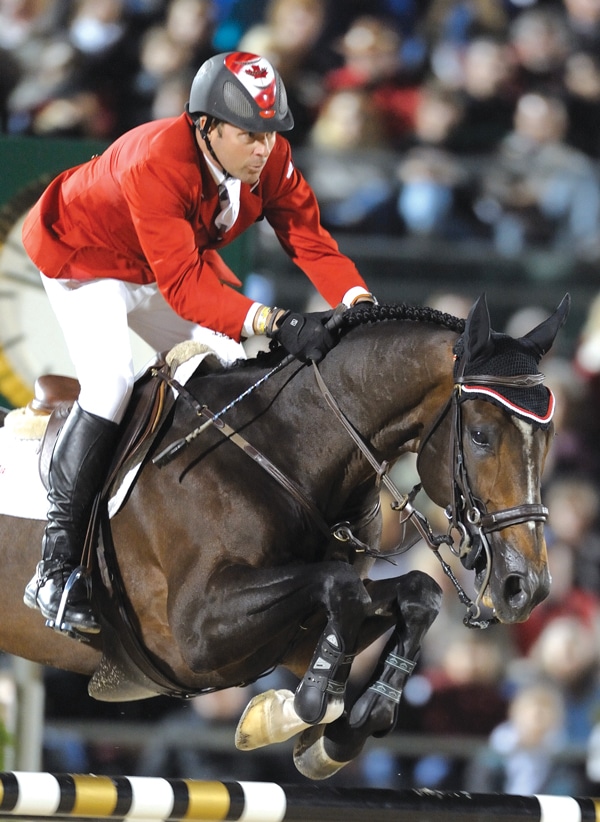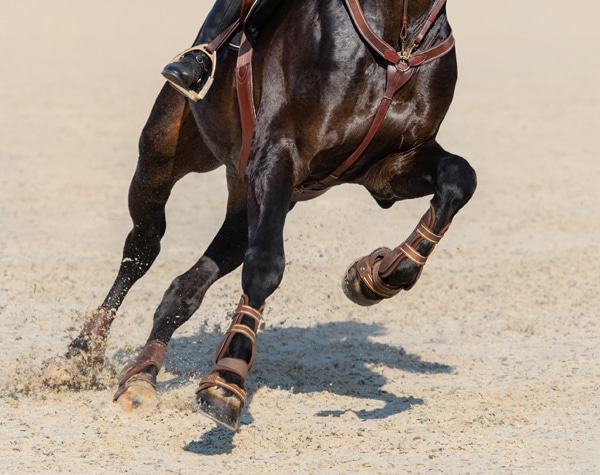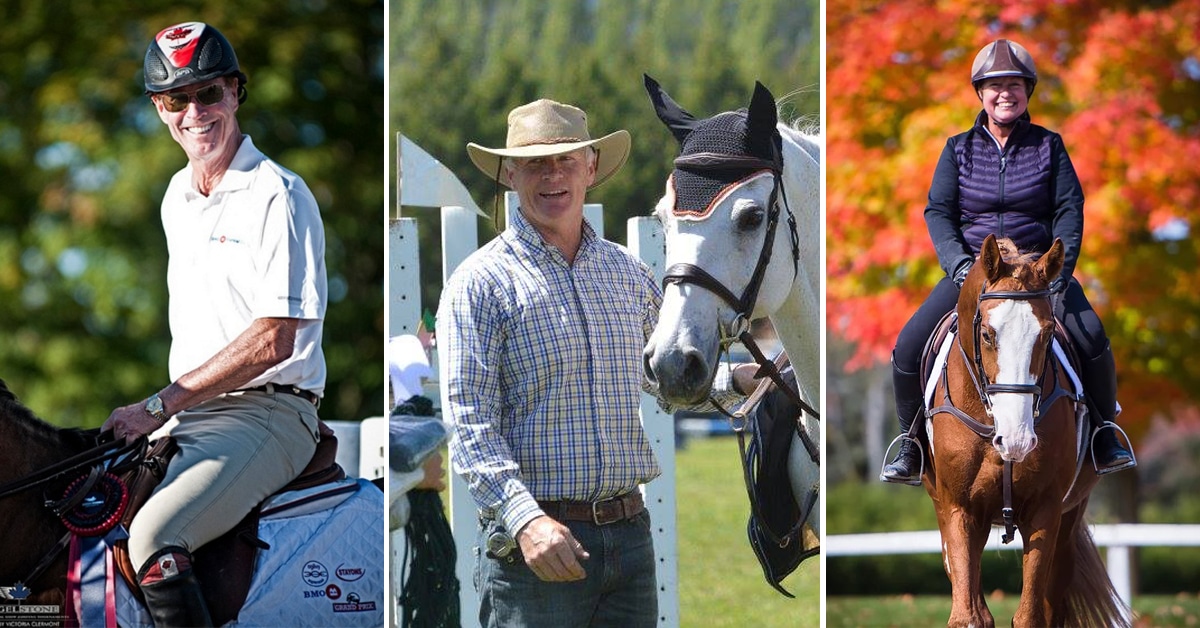It’s often said that if you don’t know where you’ve come from, you don’t know where you’re going. Horse Sport spoke to three of Canada’s experts in their field to get a better perspective on how the sport of show jumping has evolved ‒ and where it might lead.
Ten-time Olympian Ian Millar needs little introduction, as he became a household name thanks to his victories in the show jumping arena, most notably aboard the great Big Ben. Now retired from international team competition, he continues to develop young jumping talent along with his family at his Millar Brooke Farm in Perth, Ontario.
British-born Peter Holmes is a noted and popular FEI Level 3/EC Senior international course designer living in Cowichan Bay, BC, who has set tracks all over the world. Now with two young children, he will be working closer to home this year, primarily at Thunderbird Show Park, as “I like them to be able to visit, even occasionally, at the shows.”
Louise Masek runs Look Ahead Sporthorses in Halton Hills, Ontario. She rode and competed across Europe and North America, and now manages a conscientious breeding program featuring her eye-catching six-year-old licensed Hanoverian stallion, Beau Balou.
Modern Horses
“The ‘modern horse’ naturally carries itself on an uphill angle so that when it gets to the jump all it has to do is rock back and fly.”
Ian Millar:
“Today we are using a more careful blood horse that won’t take a pounding. If you land them in the middle of the jump they are not happy! The horses in the old days could have rails and ride right through the jump and they were fine and would just come back and jump higher and harder the next time. It didn’t bother them that much.
Today’s horse hates to hit a jump. In the old days you would want to get a proper bump in the warm-up before you went into the ring, but today if you hit something too hard in the warm-up area with these horses they think “that wasn’t good” and then they get backed off when they get in the ring.

Hickstead, “who galloped across the ground with his front end working away, but he was on this angle so when he got to the jump he hardly had to do anything to leave the ground.” (Clixphoto.com)
The ‘modern horse’ naturally carries itself on an uphill angle so that when it gets to the jump all it has to do is rock back and fly. If it’s level, it takes too long and there isn’t enough room to tip back and go; it has to naturally gallop uphill. One of the greatest examples of this was Hickstead, who galloped across the ground with his front end working away, but he was on this angle so when he got to the jump he hardly had to do anything to leave the ground.
A horse in nature carries roughly 60 per cent of its weight on its front feet and 40 per cent on the hind feet. When we are training we try to almost reverse those percentages, which is a function of balance, strength, and training. It takes all three to do it. If the horse has the right conformation, it makes it a whole bunch easier to get it.
When I look at a horse I want it to have a good gallop that isn’t too long and heavy that would make it too tough to carry itself and be able to solve the problems on these courses. Or I may see a horse that is lovely in every way, but it’s too slow and the rider would have to fight like crazy to make the time allowed. Even if the rider made the time allowed they would be too slow in the jump-off. Horses that are naturally fast can be on the same track as the others and still be faster. This makes riding fast less risky to faults and ups the win ratio.”
Louise Masek:
“From a purist standpoint, jumper conformation would be a higher neck set on their shoulder, a very powerful back end, the ability to rock back onto their hocks and power off the ground. A shorter back with the ability to lengthen and shorten strides and turn on a dime. Very cat-like reflexes. But a horse that may be beautiful conformationally doesn’t necessarily guarantee they’re going to jump… and jump carefully. How many meter-60 jumpers do you know that, quite frankly, aren’t conformationally correct and aren’t the prettiest out there ‒ but boy can they jump! That’s the other tough part with breeding. If you breed them, you want to sell them, so they’ve got to be pretty for the market. And a lot of people go for pretty over athleticism.
“I breed for temperament first, because I want to be able to put safe horses out there in the hands of riders that that can enjoy them.”
People are very visual, and I don’t think they understand what makes a jumper. They don’t understand that the horse has to get to the base and be able to curl up and around and over the jump, balance off the ground and have those cat-like reflexes. People don’t even like seeing that when they watch a horse free-jump here, whereas in Europe they eat that up. Here they’re so used to the hunter ride where it’s a long frame and a slow canter and leave a gap at the base of the jump and don’t clear it by too much.
The main reason I don’t personally breed to the top, top jumper lines like the Emeralds or the Numero Unos or the Glasgows is I can’t afford to have that breeding turn out an ultra-sensitive meter-30 horse that can’t go much further. Because that’s an amateur horse ‒ no pro is going to be interested. But if it has the temperament of a grand prix horse, no amateur’s going to be interested in that horse, either, because they can’t ride it. I can’t afford to take that risk, so I breed for temperament first, because I want to be able to put safe horses out there in the hands of riders that that can enjoy them. They’re weekend warriors and their horse is their outlet.
The pure jumper market ‒ the top pros, all the up-and-coming riders ‒ often just go to Europe and don’t look here at all. It’s very discouraging.
But we don’t have the means of bringing them up through the ranks in a cost-effective way. And we don’t have access to the top, top bloodlines here. It’s hard to get fresh semen into Canada with the CFIA, so you have to have a mare that can take with frozen semen. In Europe, you can get fresh semen from the top stallion, breed the mare, have a foal and be able to produce that foal to the age of four or five probably for $20-25,000. There’s no way you could do that here.
Hunter breeding is a whole different story. There are lots of good hunters here, and a good market for it. The Europeans still don’t understand it. They’re starting to ‒ they have brought a lot of riders from here over there to the sales barns to ride and turn out the hunters for when the North American shoppers go over. But I think we’re much stronger in the hunter breeding here because we know the market and we have the avenues for showing those horses.”
Evolution of Course Design
Ian Millar:
“When I started competing in the late 1960s, there was a British lady, Pam Carruthers, who was instrumental in designing the Hickstead facility in England. She was also very much a part of designing Spruce Meadows and she was a wonderful course designer. She taught us about course design and that a horse gallops on a 12-foot stride, so a course must be built on multiples of 12. If anybody did anything but that back then they were a bad course designer!
Now you rarely walk a course on multiples of 12. If you did, everybody would jump clean. As designers started playing with the distances and striding we had to teach these horses to get deeper and closer to the jumps than ever before.
Pretty soon everyone could do that. Then they started playing with the colour schemes. Leopoldo Palacios, a talented course designer, came along with his big trick at early Spruce Meadows shows where he would have about four short dark rails and at the bottom would be a white plank. Horses would look down at the plank and trip over the vertical. So we all started to build this at home and pretty soon the horses could do them perfectly.
The next question the course designers introduced was lighter material and flatter cups. Now you need an ultra-careful horse for rub-free jumping. If you touch a jump at most of these competitions it’s probably going to be on the ground. You are lucky if you can get away with a rub at all now, it’s just that careful.
These days at the championship level it’s very interesting to see how the course designers have figured out how to put all of these tests together without exceeding the heights. You can still make it a real test by the look of the jump, the location, the presentation. If it looks intimidating, the horse is going to think that way, so it has to be super-careful and brave.”
Peter Holmes:
“No longer are there a few gifted horses and riders in a class of twenty. Now, we often see many, many talented horses and riders in a class of sixty or more.”
“Course design has changed a fair bit since I started in the early 1980s (’70s if you count the local shows I designed at in my teens!). At the lower levels we still have the goals of encouraging and helping develop horses and riders through the use of rhythmical and forward-flowing tracks. This hasn’t changed much. What has changed is the quality of horses and overall skills and technique of riding.
No longer are there a few gifted horses and riders in a class of twenty. Now, we often see many, many talented horses and riders in a class of sixty or more. In the old days, the management often went down the barn aisles looking for an extra horse or two who could move up and go in the grand prix! Now we can see most of the sixty-horse class moving down for a 1.45m money class.
This increase in quality over the relatively comfortable height for the competitors magnifies the remaining details in a course. The height is not the main challenge. The time allowed is tighter to reward the more efficient riders. The jumps generally are more airy and poles lighter to test the carefulness, the cups are softer for the same reason and the colours and contrasts are more subtle so they require more focus. It is the overall increase in volume and improvement in quality of horses and riding that have driven the changes and challenged the CDs for more precision and co-ordinated teamwork in the course.
Courses should be appropriate for the level of entries and to the level of competition expected ‒ not always an easy mix. I find that a track with flow and rhythm is the best way to encourage “gallop and jump.” If the horses gallop and jump, they tend to jump well and the course is a success to me.
When prize money comes into play the details will require more focus from the competitors, but the track is much the same. Details such as jumps with soft colours, less contrast in the colours, a new fence or fences that have a ‘different’ look, possibly the water jump, test courage and efficiency. These details help separate the class without disrupting the rhythm.”
Modern Footing
Ian Millar:
“Footing ideally should absorb the concussion without robbing the power. When a horse lands in it there should be enough give that it absorbs, but not so much give that it’s hard to get out of.
Today’s modern footing sure doesn’t rob the power ‒ but it also doesn’t offer much absorption of concussion. So now we are dealing with a whole new set of injuries and issues from modern footing.
As you come through a corner in soft sand it will cup out and allow the foot to work. Today’s footing won’t cup, so when you go around the corner all the weight is on one side of the foot, which means you are straining the collateral ligaments on each side.

While sand/fibre footing has greatly evolved, many riders still prefer good turf. (©Kseniya Abramova – stock.adobe.com)
On the plus side, today’s footing does offer a level playing field for Olympic championships. It’s part of the rules that you have to have this type of ground so that no matter what happens – it can rain like crazy and it doesn’t matter how many horses land and take off in the same place – that footing will be the same from the first horse to the last horse. The economic reason for the new footing is that when horse shows are running literally hundreds of horses around all day, they have to have a footing that is basically indestructible.
Most show jumpers will tell you that the ground they love the best is good turf. We all love good turf. Take, for example, a ring like Spruce Meadows where they have put so much sand in it over the years that probably the first six inches of ground is fifty per cent sand by now. Over the years we’ve had to use corks less out there because the sand in the ground absorbs the water and it stays softer. It’s beautiful ground and when we are out there for four weeks the horses stay pretty darn sound ‒ much sounder than they do on the modern-day sand/fiber mix.”
Peter Holmes:
“Footing has evolved so much and helped the sport tremendously ‒ but there is no perfect footing. The horse wants firmness for takeoff and softness for landing. They want grip for turns and speed, but looseness for torque on the joints and ligaments. The best footing is a blend of these opposites somewhere in the middle. The best footing is commercial and can be groomed fairly quickly back to original condition throughout the day or even within a large class.
The best venues continually maintain their footing. Footing doesn’t stay the same, so what was good last year may settle and be firm this year and hard the next. Good grass footing is among the best footing, but it is not commercial. It can’t be used week in week out. Good grass footing needs to be used with care and is good in special events for its natural look and feel.”
Parting Thoughts on the Future
Ian Millar:
“I have no concern for the top level. The horses and riders are superb and the management and promotion of the sport seems to be in good hands.
My great concern is that young people whose dream it is to ride and compete will be priced out. The cost of horses and their maintenance. The cost of competitions. I hope that our industry will find ways to allow these young horse people to fulfill their dreams.”
Peter Holmes:
“Show jumping needs to evolve with the times. New and interesting competitions can increase its spectator appeal even the competitors’ appeal. Leagues and teams may be created. The Derby gave life back to the hunter ring. The Ryder Cup came back to promote golf, so perhaps Europe vs North America in show jumping, or Rest of the World vs Europe. Imagination and drive are the only limits to what more we can do with the sport.”
Louise Masek:
“I think hunters are still very strong and will remain so. Dressage is coming up, because more and more people are riding dressage. There are definitely people breeding really good jumpers. I was part of a sale where a horse bred in Guelph got sold to McLain Ward’s barn as a jumper. And then there was another one earlier this spring that got sold to Francois Mathy’s barn, or there is the odd one that goes the other way, from here to Europe, and does jump well enough, but they are few and far between.
We need more programs here and more coaches that are riding the jumpers. Even the grassroots 80 and 90 centimetre classes that we have, kids aren’t being taught to jump them correctly. They’re taught to run around like chickens with their heads cut off and it’s speed, speed speed. They’re not being taught how to be efficient and how to turn a horse correctly and how to get it straight to the jump. So until we have that mentality of jumper riders here, I don’t know how we can breed for it.
It would also be nice ‒ Europe has it and the States are starting with USEF ‒ if the breeding was mentioned with the horse show entries and the results that get published and the announcer announcing the horse and rider coming into the ring. Then people can get educated on the bloodlines.”


